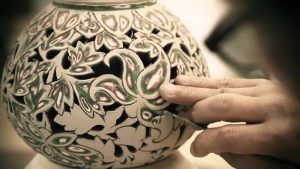Ceramic is a piece of terracotta made from a kind of clay soil, baked in an oven, glazed on a surface, decorated with various colors and motifs.
Objects which are made from baked clay contain a paste of quartz and a melting feldspar to prevent the pieces from breaking and cracking.
We can examine ceramics under two headings as durable and non durable. Durable ceramics are products whose raw materials can be kneaded with water, easily shaped and not deformed after drying. Non durable ceramics consist of materials that are not easily formed by water and deteriorate quickly when dry, even if their raw materials are made of very well grinded soil.
Ceramics was used to meet daily needs in the most primitive ages of humanity and has continued its existence until today. Ceramic works have shed light on the traditions and customs of the societies they belong to and have been their cultural, economic, artistic and political indicators.
The oldest major ceramic centers of the Neolithic period are Anatolia, Egypt and Mesopotamia. The earliest pottery to be recovered dates back to 7000 BC and has been found in Yeriko in Palestine, Hacılar Village in Anatolia and the Near East.
The art of ceramics, which was also seen in the first Turkish States, had a rich product range during the Seljuks and Ottoman Empires.
In Anatolian Seljuk architecture, ceramics are seen in mosques, masjids, madrasas, tombs, minarets and palaces. The brightest examples of the Ottoman period came to the fore in the 15th and 16th centuries. The centers of these ceramics, which are called "blue-white", are in Iznik and Kütahya. Konya, which was the center of ceramics during the Seljuks, transferred this work to Iznik during the Ottomans. Iznik gave this title to Kütahya in the 17th century. Today, when "ceramic" is mentioned, the first city that comes to mind is Kütahya.
As long as human being exists, the art of ceramics will maintain its importance in his life.
